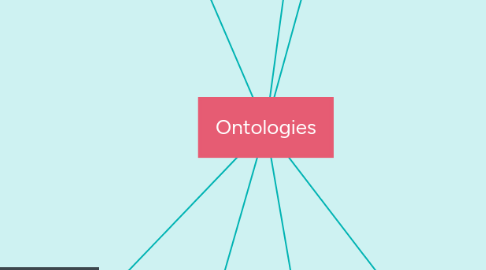
1. The Discipline of Organizing
1.1. Types of Semantic Relationships
1.1.1. Categories
1.1.1.1. Inclusion
1.1.1.1.1. is a
1.1.1.1.2. is a type of
1.1.1.1.3. is part of
1.1.1.1.4. in in
1.1.1.2. Attribution
1.1.1.2.1. is the author of
1.1.1.2.2. is married to
1.1.1.2.3. is employed by
1.1.1.3. Possession
1.1.1.3.1. has
1.1.2. Synonyms
1.1.2.1. Entity Type
1.1.2.2. Resource Type
1.1.2.3. Concept
1.1.2.4. Class
1.2. Ontologies
1.2.1. A network of relatioships
1.2.2. Web Ontology Language (OWL)
1.2.2.1. Developed by W3C
1.2.2.2. Formal Logic Based Language
1.2.2.3. Built on RDF
1.2.3. 'Essential parts in some organizing systems, especially information-intensive ones'
1.2.4. Extensive & Controlled Vocabulary
1.2.5. CYC
1.2.5.1. Created in 1984
1.2.5.2. Most extensive ontology ever created
1.2.5.3. Artificial Intelligence research project
1.2.5.4. Several hundred thousand terms
1.2.5.5. Millions of assertions that are interrelated
2. Key Words & Phrases
2.1. Knowledge Representation
2.2. Extension of Taxonomy
3. Gruber
3.1. Conceptualisation/Relationship
3.1.1. Concept
3.1.2. Objects
3.1.3. Other Entities
3.2. Knowledge Base
3.3. Knowledge Based System
3.4. Knowledge Level Agents
3.5. 'An ontology is a systematic account of existance'
3.6. Representational Vocabulary
3.7. Portability
3.7.1. Shared Terms
3.7.2. Defined at Knowledge Level
3.7.3. Common Formalism
3.7.4. Support over multiple representation systems
4. Semantic Web
4.1. FOAF
4.2. SPAR
4.3. SKOS
5. BBC Ontologies
5.1. Linked Data to connect content
5.2. Types of Ontologies
5.2.1. BBC
5.2.2. Business News
5.2.3. CMS
5.2.4. Core Content
5.2.5. Creative Work
5.2.6. Curriculum
5.2.7. Food
5.2.8. Journalism
5.2.9. Politics
5.2.10. Programs
5.2.11. Provenance
5.2.12. Sport
5.2.13. Storyline
5.2.14. Wildlife
5.3. Creative Works
5.3.1. Classes
5.3.1.1. Audience
5.3.1.2. Category
5.3.1.3. Creative Work
5.3.1.4. Format
5.3.1.5. Thumbnail
5.3.1.6. Thumbnail Type
5.3.2. Properties
5.3.2.1. About
5.3.2.2. Alt Text
5.3.2.3. Audience
5.3.2.4. Category
5.3.2.5. Created By
5.3.2.6. Date Created
5.3.2.7. Date Modified
5.3.2.8. Description
5.3.2.9. Language
5.3.2.10. Mentions
5.3.2.11. Primary Format
5.3.2.12. Short Title
5.3.2.13. Tag
5.3.2.14. Thumbnail
5.3.2.15. Thumbnail Type
5.3.2.16. Title
6. Areas
6.1. Biomedicine
6.2. Proteomics
6.3. Cultural Heritage
6.4. Geopolitics
7. Wikipedia
7.1. Components
7.1.1. Individuals
7.1.2. Classes
7.1.3. Attributes
7.1.4. Function Terms
7.1.5. Restrictions
7.1.6. Rules
7.1.7. Axioms
7.1.8. Events
7.1.9. Relations
7.2. Types
7.2.1. Domain Ontology
7.2.1.1. Domain Specific Words
7.2.1.2. Words represent things specific to an area e.g. 'playing card and 'video' card
7.2.2. Upper Ontology
7.2.2.1. BFO
7.2.2.2. Dublin Core
7.2.2.3. BORO Method
7.2.2.4. GFO
7.2.2.5. SUMO
7.2.2.6. UMBEL
7.2.2.7. OpenCyc/ResearchCyc
7.2.3. Hybrid Ontology
7.2.3.1. Domain Ontology
7.2.3.2. Upper Ontology
7.3. Engineering
7.3.1. Development of ontologies for a domain
7.3.2. Problems
7.3.2.1. Current?
7.3.2.2. Specific?
7.3.2.3. Coverage?
7.3.2.4. Supportive?

